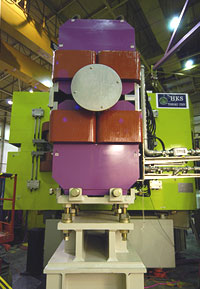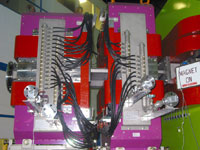2004 News Release - Big Experimental Equipment
Big Experimental Equipment

The High Resolution Kaon Spectrometer was built by a collaboration based at Tohoku University in Japan for an experiment designed to produce Lambda hyperons inside nuclei. Photo credit: Jefferson Lab
Hall C's HKS
Experiment E01-011 is scheduled to run June 18 - Aug. 7, 2005. In it, researchers plan to create hyperons, strange particles thought to reside in neutron stars. Lambda hyperons, like protons and neutrons, are composed of even smaller particles called quarks, along with a swarm of gluons that "glue" the quarks together. While protons and neutrons contain two different kinds of quarks, called "up" and "down," Lambda hyperons can contain three: up, down and "strange" quarks. According to Osamu Hashimoto, a Hall C user from Tohoku University in Japan and lead scientist on the experiment, he and his colleagues aim to produce Lambda hyperons, or Lambdas, inside atomic nuclei to learn about the nucleus of the atom and about matter that contains strange quarks.
In the experiment, researchers will send a 1.8 GeV (billion electron-volt) beam of electrons into four targets: one made of carbon, one of silicon and two of boron. Individual electrons will strike the protons and neutrons in the nuclei of the target atoms. When an electron slams into a proton, a shower of elementary particles, including quarks and gluons, pop into existence. When two strange quarks appear, a strange quark and an anti-strange quark, the struck proton may become a Lambda hyperon by swapping an up quark for the strange quark. The nucleus that now contains this Lambda hyperon is called a Lambda hypernucleus. "The ordinary nucleus consists of protons and neutrons. That means that the ordinary nucleus is made up of up quarks and down quarks - just two kinds of quarks. The Lambda hypernucleus contains three kinds of quarks: up, down and strange quarks," Hashimoto explains.
The up quark spit out by the proton and the anti-strange quark created in the collision bind together to form a kaon. This new particle then travels out of the nucleus. "So the signature of producing hypernuclei is detection of this kaon," explains Satoshi Nakamura, an associate professor at Tohoku University and experiment collaborator.
The High Resolution Kaon Spectrometer (HKS) was designed to detect the kaons. The spectrometer was built over a period of four years by the experiment's more than 50 collaborators at a cost of about three million dollars. The project was funded by Japan's Ministry of Education, Culture, Sports, Science and Technology. The magnets and detector package were originally built in Japan and shipped to Jefferson Lab. Beginning Jan. 24, 2005, Hall C staff and researchers will spend five months installing more than 40 pieces of equipment for the experiment, running beam tests and commissioning the apparatus.
As particles enter HKS, a pair of quadrupole magnets will focus them into a beam, and a third magnet will bend the paths of the particles around a curve and into a drift chamber. This detector is designed to measure the particles' angle and position. "By bending a particle's path, we can measure its momentum. We would like to measure kaons, but in reality, protons and pions will also be present, so we need to separate the kaon from these," Nakamura says.
The next series of detectors are designed to do just that. One will use Aerogel to discriminate between pions and kaons, and the second will use chemically-treated water to separate the kaons from the protons. The result is that HKS will gather data on just the kaons.
An Enge spectrometer containing a drift chamber will measure the speed and position of the electrons that struck and recoiled from the target. After the run, the experimenters will combine the information about the electrons and kaons they've measured to reveal information about the nucleus of the atom and about the behavior of matter that contains strange quarks.
Look for expanded versions of each of these three stories in upcoming editions of Jefferson Lab's On Target Newsletter.
Thomas Jefferson National Accelerator Facility’s (Jefferson Lab’s) basic mission is to provide forefront scientific facilities, opportunities and leadership essential for discovering the fundamental structure of nuclear matter; to partner in industry to apply its advanced technology; and to serve the nation and its communities through education and public outreach. Jefferson Lab is a Department of Energy Office of Science research facility managed by the Southeastern Universities Research Association.


